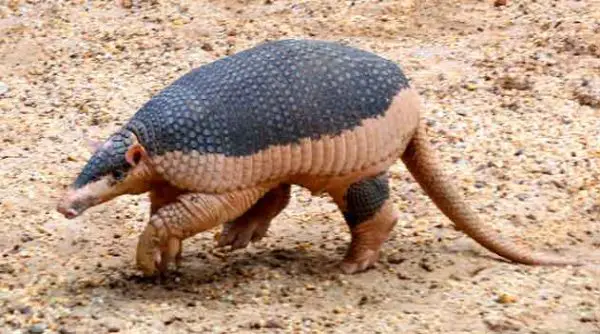The answer to the question in the title is yes, there are armadillos living in the Brazilian Amazon region and the best known species is precisely the famous giant armadillo. This species of armadillo is well known for its size and size. Its scientific name is Priodontes maximus., but in Brazilian popular language, besides being known as armadillo canastra, it can also be called by other names, among them is the name of tatuaçu and armadillo carreta. This armadillo can also be seen in other locations in South America and not just in Brazil. Its size can reach an impressive 1 meter in length added to a combination that is around 60 kilos in weight, in addition, its tail can be enormous reaching more or less 50 cm, it is currently the largest armadillo still alive that inhabits on our planet. Its paws are very strong and robust, but what draws the most attention are its strong and large nails that can reach 20 cm in length.

Armadillo
Its food consists of insects and other types of animals, such as ants, termites, spiders, larvae and even snakes, all these foods the giant armadillo obtains from turning over the soil with its nails. Despite its occurrence in the Amazon, it can also be seen in Brazil in the cerrado region, in the most central part of our country, in addition, it is also present in Argentina and Venezuela. Despite its wide range of occurrence, the giant armadillo is a species considered vulnerable in the school of conservation status, as its reproduction takes place very slowly, and the female armadillo gives birth to only one offspring each of their pregnancies, added to this is the fact that their reproductive period occurs every 3 years. So if you are very hunted.

giant armadillo
Despite its conservation status until recently still indicating that it is a vulnerable species, currently the giant armadillo already fits into the category of endangered species, unfortunately. It is considered a threatened or high-risk species, since it is very difficult to find this species of armadillo even in its natural habitats, where in other times it was abundant and easily seen. There are many factors that unfortunately contribute to this situation, first there is the illegal hunting of armadillos, so that their meat can be consumed, in addition to the use of their resistant armor, in addition, many animals have already been victims of being run over. Another thing that has been making the situation of the armadillos difficult is the loss of areas of forest and native vegetation where they used to live.
Its habits are especially solitary, but there are still not many conclusive studies, if this happens because a large part of the population was hunted and there is a lot of fragmentation of its natural territory (as explained above), or if it really is a typical characteristic of this species. , normally they are only seen in more than one individual when the mother is still caring for her young or when the female is in the breeding season. Remembering that the Pantanal is also one of its original habitats and the fires that take place there do not contribute anything to the preservation of its species, in fact they do not contribute to the preservation of any species, neither animals nor vegetation. Armadillos also have the characteristic of living near water courses or lakes,
A very relevant piece of information about them is that they don’t adapt very well to life in zoos, in fact, zoos are not that nice places, nowadays we are much more aware that they take animals from nature to live in captivity only for the meaningless entertainment of human beings, without any other type of benefit to anyone, a light at the end of the tunnel is that there are many movements that defend the end of zoos, including in some places the acquisition of new animals for living is already prohibited caged, that’s great, what we hope is that things keep changing for the better for the animals, who did nothing to deserve this kind of treatment.
In addition to the fact that the giant armadillo is the largest armadillo that lives on our planet today (in the past there were much larger species that have already become extinct), therefore its importance for science is unprecedented, there are also other ecological issues involved. Obviously we have to consider the food chain, because it is prey of some species, while it is predator of others, in this way, in its role as predator, the giant armadillo contributes to the maintenance of the ecological balance, so that some other species do not grow in such a way. indiscriminately, while it is prey for other species so that they have food to grow in population numbers in a balanced way.
As we well know, natural ecological processes are all interconnected, a species of mosquito that may be extinct today may at first not seem to have much importance, but it interferes with another species, which interferes with another, until it reaches an ecosystem level. very advanced and that we didn’t even imagine, obviously at some point in this chain the consequences reach human beings. Another ecological function of the giant armadillo is as an engineer of the forests, since it builds many holes throughout its life, everywhere it passes, so when it changes location these holes are left behind and with it others animals take advantage of them to use them as housing and protection. One of the species that use these holes made by the giant armadillo is the short-eared wild dog,
